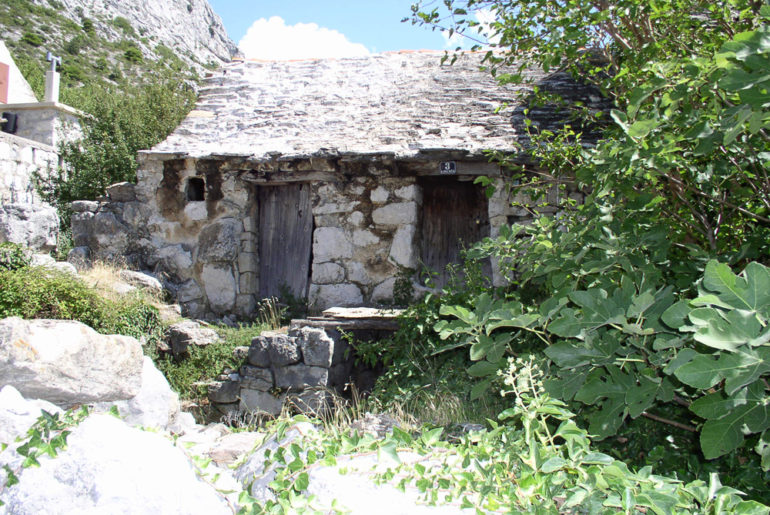This post is also available in: Croatian
[nivo effect=”fade” directionNav=”button” controlNav=”true” width=”720px” height=”360px”]
[image caption=”Eko-etno sela”]http://hotspots.net.hr/wp-content/uploads/2012/03/eko-etno-sela_3.jpg[/image]
[image caption=”Eko-etno sela”]http://hotspots.net.hr/wp-content/uploads/2012/03/eko-etno-sela_2.jpg[/image]
[image caption=”Eko-etno sela”]http://hotspots.net.hr/wp-content/uploads/2012/03/eko-etno-sela_1.jpg[/image]
[image caption=”Eko-etno sela”]http://hotspots.net.hr/wp-content/uploads/2012/04/Eko-etno-sela.jpg[/image]
[/nivo]
The purpose of the “Ethno-eco” villages project, launched by the Split-Dalmatia County in cooperation with local government units, is to stop the trend of selling off native land and to restore life in the long-abandoned villages. Old Dalmatian houses on the coast and in the Dalmatian hinterland and on the islands became increasingly popular in the real estate market, and heirs who have long ago abandoned their “native country”, attracted by the profits easily sell their “native lands”. To stop the trend of bargains of authentic Dalmatian villages and return them to life, Split-Dalmatia County in 2005 launched the “Ethno-Eco-villages” project as a unique tourist product.
From 2005 to the end of 2009 the Split-Dalmatia County invested over the 5,600,000 kunas in the project.
Major Ethno-Eco-villages are:
Humac – Municipality of Jelsa –Hvar
[styled_list style=”circle_arrow” variation=”slategrey”]
- Co-funded the study and drafting conservation UPU
- Co-financed the purchase of real estate (by municipalities) to create an ethnological collection
- The tanks renewed, belvedere arranged
- Excursion ethno-eco-village near the Grapčeva cave
- There is a manufacturer of organic wines within the ethno-eco village
[/styled_list]
Bast and Topići – Municipality of Baška Voda
[styled_list style=”circle_arrow” variation=”slategrey”]
- Conservation study
- UPU
- Repurchase of old walls in the course of ethno-eco collection
- There are traditional restaurant and accommodation facilities in the old stone houses
[/styled_list]
The old Podstrana – Municipality of Podstrana
[styled_list style=”circle_arrow” variation=”slategrey”]
- Conservation study and UPU
- Arranged the old reading room facility (owned by the municipality)
- There are accommodation facilities and hiking trails
- Tourists are already coming in excursions
- Maintenance of cultural events
[/styled_list]
Of the more significant, it is important to mention Murvica, the municipality of Bol, Velo and Malo Grablje, the town of Hvar and Dol, the municipality of Postira-Brač.
Goal of the project is to preserve our cultural heritage and to create high-quality tourism products. The point is to preserve buildings of traditional architecture and the original matrix of the settlements, and present them as part of the Croatian tourist identity, because if they sell out, we will lose our native lands for all. With the restoration of the displaced and abandoned villages, the plan is to revitalize traditional crafts and trades, and to evaluate better local food and wine products, such as varietal wines, olive oils and foods typical of the Dalmatian region. Old Dalmatian villages with their local architecture, or “ethno-eco-villages”, will become a new brand in the Croatian tourism. “The goal is to get this project implemented in all coastal counties in order to simultaneously preserve and commercially utilize our traditional folk architecture. The project will revive the traditional Dalmatian houses and commercial buildings, schools and churches, the old infrastructure and build new ones. The project will also stop resettlement of old villages, and return the domicile population to their homes.
The project provides for the commercialization of accommodation and catering facilities (rural tourism), the revival of traditional manufacturing and traditional crafts, and healthy food production. In addition to co-financing, the Management ethno-eco-villages plan is provided, and the project was positively evaluated by the Ministry of Culture, with whom we work, the Ministry of Tourism and the Department for Regional Development of the Ministry of Economy.
The project was as one of the joint tasks listed in the “Declaration on Rural Tourism” signed by 16 Counties. It has also been presented on the first Croatian Congress on Rural Tourism, held in Hvar last year, and at the International Conference, “Tourist opportunities of the Adriatic hinterland ” in Mostar, in April 2008.
Text: Joško Stella
This post is also available in: Croatian


